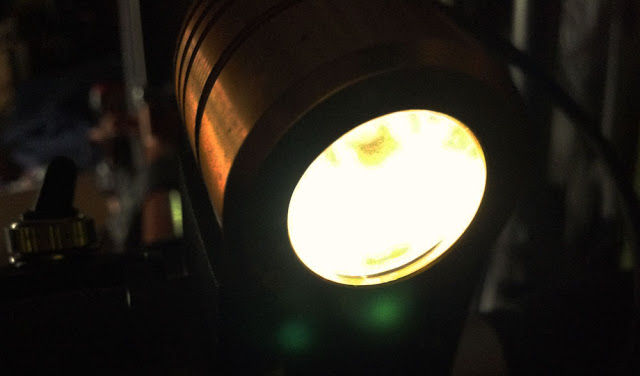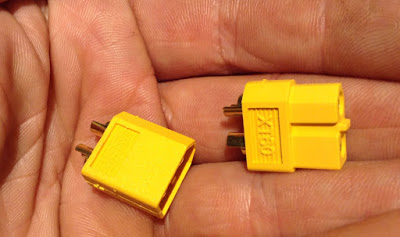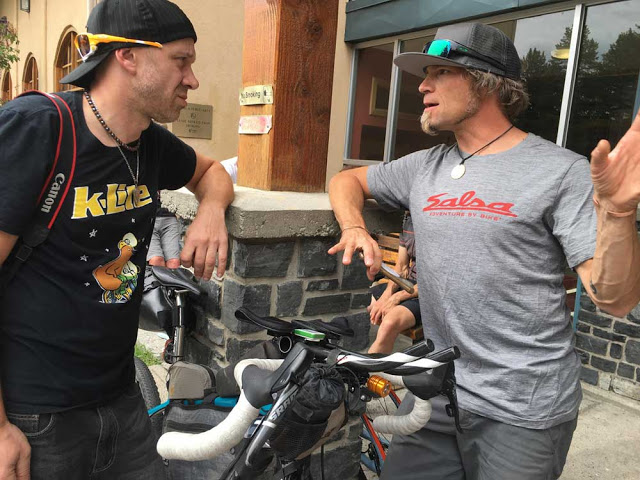Fast forward twenty years … you’ve just spent a week’s wages on a Cat Eye twin halogen light. The eerie yellow glow it emitted opened up a window of possibility; a fairly small window I grant you because the battery would be flat after two hours but non the less, these two beacons of lighting technology helped to transform your riding, a seed was sewn and a cycle began. Every year MBUK would entice you with a promise that this coming winter would be your best winter ever and each September they’d show you things that were brighter, smaller, lighter and shinier than they were the September before. Over the next decade you amassed a lighting arsenal bright enough to singe retina at half a mile and costing more than you dare recall or certainly admit to. Each passing year would herald the arrival of a new weapon and each year another perfectly good light would find itself relegated to the cardboard box under that old length of worktop that passes for a workbench. It’s a tale I’m sure many can relate to but I believe it’s a tale less often told around these parts of late and the reason for that? … The dynamo.
 |
| As soon as the wheel turns it lights up … took me 2 hours to recover the sight in my left eye after taking this. |
As bikepackers we place different demands on kit and equipment to that of many other cyclists and as the duration of a ride extends from hours to days to maybe weeks, those demands increase and our priorities alter. Having the very brightest light ceases to be of greatest importance. Sure, you still need a light capable of fully illuminating your chosen path but the ability to do it without the need for recharging will far outshine an additional two hundred lumens. The modern technology we employ in our journey ‘back to nature’ and in our quest for ‘self-sufficiency’ also have a bearing and for some, the desire to keep things charged might even be stronger than the need to see where they’re going … perhaps it’s fortunate that the K-lite Bikepacker Pro allows you to do both.
I introduced the Bikepacker Pro a while ago. I explained how and where I mounted everything and ran through the numbers and specifications, so all you need to know now is how it works … my dynamo of choice in this instance was a Shimano DH-3D32, it may be a crap name but the money Shimano save on branding means these hubs cost considerably less than many others and so far it’s proved itself to be 100% reliable. Whichever dynamo you buy, just make sure that it produces 3W and not 1.5W as some do. With everything connected and the bike suspended from a stand, the first thing I did was give the front wheel a quick spin in a ‘can’t help myself’ kind of way. This was the moment I received my first surprise, that’s right, the light lit up. If you’re wondering why that’s surprising, it’s because all the other dynamo lights I’ve used require a wheel to be spinning both faster and for longer before flickering into life. Those paying attention will notice below that Kerry (Mr K-lite) mentions a low speed boost system which I assume is the reason for this near instant illumination. You do need to bear in mind that a dynamo light isn’t like a battery powered one; you won’t receive the lights full output until your speed increases, however the fact remains that the K-lite produces useable light at speeds lower than that of which most dynamo lights do. Below a ‘certain’ speed there is a little flickering but I only noticed it on a long 20% gradient, with a headwind and nearly 100 miles in my legs … I’m sure you can imagine just how slow forward movement was at that point and just how unconcerned I was about a flickering light.
 |
| Okay, it’s not a sexy name but it does appear to work well. |
Contrary to how it sounds, a ‘stand light’ isn’t a light on a stand but is in fact a ‘stand by light’. It’s an important consideration when powering lights via a dynamo because without one, the second you stop moving, your lights go out. Stand lights are powered by a capacitor which is charged by the dynamo. When you stop, the charge contained in the capacitor powers the light – it isn’t a battery but if it helps, you can think of it as one. On the road, a stand light is an absolute necessity but off-road, although still required, it’s probably less important and I think K-lite have got the balance of brightness and run time just right. It’s bright enough to allow you fumble with that bailing twine holding a gate closed or read a map but it dims to a glow after a reasonably short time if you remain stationary. Personally, I can’t sleep with a light on, so having a light that’s still producing a considerable output six hours after I stopped moving is annoying … especially as I’ll only remember to put something to dampen the glow over it once I’ve got into my sleeping bag.
Anyone who’s read the previous introduction will know that the K-lite control box features a High / Low switch which allows you to choose between less light / less drag or more light / more drag. I was told that although the difference in output would be obvious (it is), any difference in wheel drag would be much harder to detect. Undeterred by this information, I spent (some would say wasted) considerable time riding the same sections first in low and then in high. I’m not renowned for sensitivity, so despite my best efforts at trying to convince myself otherwise, it’s little surprise that in daylight, I couldn’t tell which setting the light was in. Maybe someone more in tune with themselves would notice something but even then, it might require the use of measuring equipment rather than simply ‘feel’. Alongside the lighting output switch, the K-lite also features a lights / charging ‘splitter’ switch. It’s a very useful addition as it allows you to run one single pair of wires from the dynamo and direct current to where you want it without unplugging any wires … I appreciate that doesn’t sound exciting but it makes a big difference in practice. One thing you really do need to remember is that, the Bikepacker Pro is not a regulator. For the hard of understanding, that means DO NOT plug your phone directly into the charging output from the switch YOU WILL BLOW YOUR PHONE UP. You must first pass the current through something like a Kemo or Sine-wave in order for it to be converted into a useable 5v DC. It’s also worth noting that, the charging output lead on the K-lite is fitted with a male XT60 connector, so if you want your regulator to play nicely, you’ll need to fit it with a female XT60.
 |
| In case you’re unsure, these are XT60 connectors – you’ll need some. |
Once you’re rolling at any kind of reasonable pace, the K-lite punches out a nice ‘floody’ hole through the darkness. There’s virtually no halo effect, dark patches or rings that plague some lights. Although fairly wide spread, the beam reaches far enough into the distance to provide plenty of warning about what lies ahead. Just like any light, you will find yourself in a shadow when riding with others equipped with something more powerful but if you pick your place in the pack and stay at the back, it’s no cause for concern. On solo excursions, the only time I turned my helmet light on was while negotiating those steep, rocky sections where speed is inappropriate and getting things wrong would end quite badly.
It’s probably best to view the Bikepacker Pro as a system rather than simply a light. Obviously, it’s possible to set up any dynamo light in a similar way but K-lite have removed much of the effort and thought required to do it. Given that fact, it’s perhaps surprisingly that they’ve also managed to incorporate room for some imagination and creativity in how you use it … and once you have used it, it becomes quite clear that it was designed by someone who not only understands resistors and diodes but bikepackers too.
I asked Kerry if he’d mind answering a few questions and he kindly agreed, so here’s part two of our double feature.
1/ How did K-lite come about? Was it simply a case of you making stuff for yourself because you couldn’t readily buy what you wanted?
https://www.bikepack.ca/podcast/2017/7/6/32-k-lite basically, I needed stuff that just wasn’t there, so had to make it myself….in the end others liked it and it took off.
K-lite has developed a low speed boost system for modern dynamo lights which boosts the power at low speed making the lights usable for off road … this is what makes K-lite so bright and produces so much power at low speed
Given the high failure rate of the tiny micro USB plug that charges the USB cache battery (this is not made to be outside) 2 smaller 5000mAh units are ideal. One to use and one to charge…. and it also provides a good backup.
 |
| Kerry and JP talk lights or maybe what pizza to order. |
4/ At present, what’s preventing dynamo lights from producing the same light output as battery powered lights?
Really, the limit is in the hub as they only produces a 3-5w output. With the K-lite booster its pushes it to 7w and brings it close what battery lights output….current K-lite lamps are 1200-1300lm which is pretty darn bright!
Next season I will have some new lamps out and will be working with better beam patterns and higher outputs…..hubs / batteries will mostly stay the same.
SP look to have there bearing issues more sorted out, however SON is German made, and these tend to be more robust over time, so SON is my personal preference for my long distance bike … but I have a SP hub on my mountain bike that’s still going strong.
I have been helping people get the correct USB cache battery but due to odd firmwares this is hard to do… so I am now working on a new USB charger just for the Garmin to keep it quiet, and ‘nag screen’ free … details soon.
Some bikes do come ‘stock’ with dynamo hubs – mostly touring models… so it’s is happening and it’s a great thing!!
The bottle dynamo is back baby, and it’s smaller than ever but they are low power … if you want to charge stuff then best stick with dynamo hubs.
I use dynamo for front and rear lights and AA batteries for my Etrex. I only use USB re-charge on longer trips. I’m old skool, I’m not married to my phone 24/7 … so this works just fine for me.
K-lite is available in the UK through Travers Bikes.
WOW, great write up, thx so much for sharing!!!!
Do you have any kind of comparison between the K-Lite and Exposure Revo lights? I'm currently looking at getting Hunt wheels, Revo light and the igaro d1 usb charger, but this looks like an attractive alternative.
It's always difficult to photograph beam patterns, etc. However, on paper the K-lite is brighter and that seems to be backed up with real world experience (especially noticeable at lower speeds). In my mind the K-lite is also easier to use when you require charging capability rather than simply a light. Just remember Gareth, you'll still require something like the Igaro to regulate charging current.
Awesome, thanks for the advice!